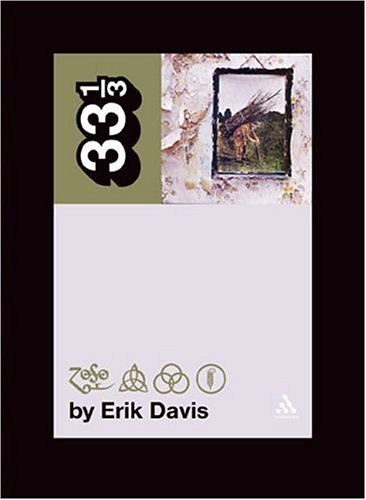"Standing on a Hill in a Mountain of Dreams..."
So, it's official.
I'm in the midst of a Zeppelin binge. This happens every 6 to 9 months (yeah, I just made the face), and each time it seems to be sparked by a different catalyst. This time around, it was a late Christmas gift from Ben that got me going:

This is one of a series of books collectively titled 33 1/3, which chronicles a host of pivotal albums, from classic rock gems (the Stones' Exile On Main Street and the Beatles' Let It Be among them) to more modern whine-rock obelisks (like Radiohead's OK Computer). The books are written by, and from the perspective of, devoted fans of the band/album of choice, and, if the Zeppelin edition is any indicator, abound with facts, anecdotes, theories, and history of the band at the time of the album's conception.
Needless to say (at least to anyone who knows the basics of Zep), their fourth record is their most heralded, most mysterious, and most controversial release. From the band's then-unheard-of decision to strip any and all text from the album jacket, leaving a nameless tome emblazoned with four ambiguous sigils, to the accusations of devil worship and Satanic messages interlaced within the groove of the vinyl, this is a much-storied recording. Author Erik Davis likens the record to a mystical journey across, and decidedly beyond, our world.
Not that I need much more than a slight nudge to binge on my lifelong favorite band, but the book has re-ignited my interest specifically in this record. Incidentally, the "untitled" record is known by a myriad of monikers: Led Zeppelin IV, Zoso, Runes, Four Symbols, and others... but the official name of the record IS the four ancient, unpronounceable symbols. After turning the final few pages last night, I gave the album two very focused listens: first the vinyl (on a turntable stereo that once belonged to my Mom when she was 16, but now graces my own humble shoebox of this world), and then on CD. With the book's discussions of themes, motifs, recording specifications, astral worlds, "light and shade," and various mythologies and legends echoing in my head, I tried to let every second of the record engulf me.
All this fanfare stood to reinforce something I already clearly knew: I absolutely love this record, from top to bottom. But taking such a specifically academic approach to the listening has helped to open new aspects of it to me. By the swampy outro to the closing track "When The Levee Breaks," I closed my eyes and felt the sound wash and warble all around me, feeling that I was sinking, being washed away by the incoming torrential flood the song suggests, "going down." Call it power of suggestion if you will, but this book has helped me to appreciate an already-memorized record in new ways. I know every word, every note; but my listens last night were revelatory.
I'm keeping an eye out for other books in the 33 1/3 series, specifically Neil Young's Harvest, (which is tied with Zuma for my personal favorite in Neil's expansive catalog) and DJ Shadow's Endtroducing. The idea of a book like this about Shadow's landmark debut practically makes me salivate.
Like a black dog, with eyes that shine, burning red...
*****N*T*G*****
Never hesitate to comment!
I'm in the midst of a Zeppelin binge. This happens every 6 to 9 months (yeah, I just made the face), and each time it seems to be sparked by a different catalyst. This time around, it was a late Christmas gift from Ben that got me going:

This is one of a series of books collectively titled 33 1/3, which chronicles a host of pivotal albums, from classic rock gems (the Stones' Exile On Main Street and the Beatles' Let It Be among them) to more modern whine-rock obelisks (like Radiohead's OK Computer). The books are written by, and from the perspective of, devoted fans of the band/album of choice, and, if the Zeppelin edition is any indicator, abound with facts, anecdotes, theories, and history of the band at the time of the album's conception.
Needless to say (at least to anyone who knows the basics of Zep), their fourth record is their most heralded, most mysterious, and most controversial release. From the band's then-unheard-of decision to strip any and all text from the album jacket, leaving a nameless tome emblazoned with four ambiguous sigils, to the accusations of devil worship and Satanic messages interlaced within the groove of the vinyl, this is a much-storied recording. Author Erik Davis likens the record to a mystical journey across, and decidedly beyond, our world.
Not that I need much more than a slight nudge to binge on my lifelong favorite band, but the book has re-ignited my interest specifically in this record. Incidentally, the "untitled" record is known by a myriad of monikers: Led Zeppelin IV, Zoso, Runes, Four Symbols, and others... but the official name of the record IS the four ancient, unpronounceable symbols. After turning the final few pages last night, I gave the album two very focused listens: first the vinyl (on a turntable stereo that once belonged to my Mom when she was 16, but now graces my own humble shoebox of this world), and then on CD. With the book's discussions of themes, motifs, recording specifications, astral worlds, "light and shade," and various mythologies and legends echoing in my head, I tried to let every second of the record engulf me.
All this fanfare stood to reinforce something I already clearly knew: I absolutely love this record, from top to bottom. But taking such a specifically academic approach to the listening has helped to open new aspects of it to me. By the swampy outro to the closing track "When The Levee Breaks," I closed my eyes and felt the sound wash and warble all around me, feeling that I was sinking, being washed away by the incoming torrential flood the song suggests, "going down." Call it power of suggestion if you will, but this book has helped me to appreciate an already-memorized record in new ways. I know every word, every note; but my listens last night were revelatory.
I'm keeping an eye out for other books in the 33 1/3 series, specifically Neil Young's Harvest, (which is tied with Zuma for my personal favorite in Neil's expansive catalog) and DJ Shadow's Endtroducing. The idea of a book like this about Shadow's landmark debut practically makes me salivate.
Like a black dog, with eyes that shine, burning red...
*****N*T*G*****
Never hesitate to comment!
 ...
...


1 Comments:
Hey, that's why you've got a wife!
Post a Comment
<< Home